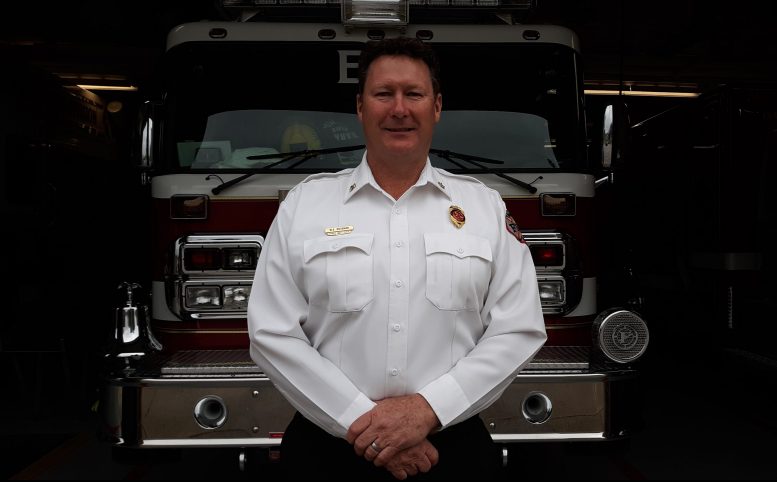By JAN LARSON McLAUGHLIN
BG Independent News
When Bowling Green Fire Chief Bill Moorman sees images of his charred homeland, his heart aches for Australia, its people and its wildlife.
“You see the pictures and it’s like a war zone,” Moorman said Monday.
Moorman grew up in the state of Victoria, in a town called Mt. Beauty, between Sydney and Melbourne in southeastern Australia – one of the vast areas hit by wildfires.
His four siblings still live in the region – with two of them being given evacuation orders earlier this month. His brother, who has a farm there, refused to leave.
“He’s stubborn like me,” Moorman said. “He’s going to stay and defend his house.”
The primarily volunteer firefighting force is counting on individuals to stay and help where they can, Moorman said.
In the case of his siblings, rain came over the weekend, and the evacuation orders were lifted.
“Fortunately, the fires didn’t come into town,” he said. “The surrounding area was not so fortunate.”
The threat is long from over.
“I’m staying in constant contact with my family,” the chief said.
Moorman knows a bit about fighting wildfires in Australia – having been a volunteer firefighter there himself from age 18 to 25, before coming to the states.
But he knows the wildfires he fought were nothing like those faced now in Australia.
“This is unprecedented. They’ve never seen anything like this in Australia – and we get a lot of wildfires there.”
The fires are racing through sparsely populated areas, fed by drought conditions and record temperatures reaching over 120 degrees recently in Sydney.
So far, 18 million acres have been ravaged by fires – compared to 2 million acres in California last year and 2.2 million acres in the Amazon recently.
“This thing is massive in comparison,” Moorman said.
There are 28 known fatalities, though the chief expects that number will grow. One of those killed was a volunteer firefighter from Moorman’s hometown. He was reportedly killed after the fire became so hot that it created its own weather system, which picked up the fire truck and slammed it to the ground. Australians know that phenomenon as a fire cyclone, which acts like a tornado, Moorman said.
Some of the flames are shooting up close to 300 feet in the air, spreading sparks to start spot fires far ahead – making it difficult to fight, he said.
The wildfires are responsible for killing more than one billion animals, like koalas, wallabies and kangaroos.
“The concern is entire species are being wiped out,” the chief said. “The animals have been decimated.”
More than 1,300 homes and 3,000 other buildings have been destroyed.
And the ocean near the fires is full of black sludge – “which is obviously going to have long term effect,” Moorman said.
Australians are accustomed to wildfires. But not this many, for this long, with this extreme heat.
“This is unlike anything. It’s leaving entire areas scorched,” he said. “It’s not just isolated locations – it’s nationwide.”
The Aborigines have practiced fire management for 10,000 years or so, Moorman said. They conduct small burns, where the grasses are burned, but the heat does not get so intense that it kills the trees.
“They know when the conditions are right,” he said.
“These trees are used to having fires,” but not so intensely hot that it kills the roots and seeds, he said. “It’s making entire areas sterile.”
Somewhere in the last couple decades, the prescribed burns were dropped from Australia’s forest management practices – perhaps for political reasons or maybe funding problems, Moorman said.
“There’s a lot of speculation why this is happening,” with many blaming global warming, he said.
Without the small prescribed burns, the grasses have been allowed to get tall, and the oily flammable leaves from eucalyptus trees have gathered on the ground.
“There’s so much fuel on the ground,” Moorman said.
Combine that with record high temperatures and drought conditions – and much of Australia is burning
“To see the devastation is incredible,” he said.
Further concerning is the fact that the fire season has barely just begun.
“These fires have been going on since October,” Moorman said. “It’s just coming into the high season right now.”
Moorman has several friends in the voluntary firefighting forces in Australia. They are exhausted.
“They are away from their jobs. They are away from their families. They are tired. And it’s not over.”
Moorman, who was last home about four years ago, has considered going to lend a hand. But as fire chief in Bowling Green, his responsibilities here are heavy.
“I’ve thought about it,” he said.
Moorman remembers fighting bushfires when he was a younger man. Teams of firefighters would be dropped off by helicopters to put up fire breaks or put out hot spots.
Help is now coming from around the world, with firefighters traveling to Australia from countries like Canada, New Zealand and the United States. The Australian Army and Navy have also helped – saving 4,000 people trapped by blazes on a beach.
Australians are a resilient people, Moorman said. But his homeland is in desperate need of rainfall and cooler temperatures.
“Australia is just baking in this heat,” Moorman said. “When you’re coming up against Mother Nature, Mother Nature is going to win most of the time.”

